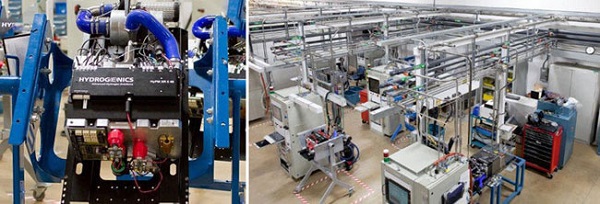The world is getting pretty good at producing renewable power, as solar and wind continue to become more efficient, less expensive and more widely adopted. Renewable fuel, however – beyond problematic biofuels – is more of a challenge, but there are signs of progress, in Germany in particular.
The latest advance comes in Falkenhagen, a little town about 45 miles east of Berlin. There, E.On is closing in on putting to work a system that uses power from a nearby wind farm to turn water into hydrogen, which is then shot straight into the area’s natural gas system. Though hardly a behemoth at 2 megawatts, the company responsible for building the hydrogen production facility for E.On, Hydrogenics of Ontario, Canada, called it the “largest power to gas facility in the world.”

E.on said it ran a three-hour test of the system, producing and putting to use 160 cubic meters of hydrogen, and hopes to have the “P2G” unit in service in late August:
Once operational, it will use surplus renewable-source electricity to produce about 360 cubic meters of hydrogen per hour. It will therefore harness renewable-source electricity that otherwise could not be fed into the grid. The region’s wind farms already frequently produce more electricity than the local grid can handle.
So what this is, really, is a way to store wind power. Instead of turning off the turbines, or using the power to move water up a hill (effective but site-specific and expensive pumped hydro) or charge a battery (expensive), it’s displacing a fossil fuel.
What’s especially interesting here is that last step — the use of the hydrogen in the natural gas pipeline. We recently reported on a report commissioned by the U.S. Department of Energy, “Blending Hydrogen into Natural Gas Pipeline Networks: A Review of Key Issues,” in which the authors sound a fairly optimistic note about the possibility of putting the country’s extensive gas pipeline system to work for clean hydrogen’s benefit. They don’t give the idea a 100 percent endorsement — because of the nature of hydrogen, the natural gas system can only take small percentages without extensive reworking — but their review of the issues says that the pluses appeared significant enough to warrant further study. So while the E.on project in Germany is fairly small at 2 megawatts, it should provide valuable insight that will help guide subsequent approaches with the technology.
Other similar approaches include putting hydrogen produced from excess renewables to work in fuel cells, and reacting it with CO2 from bioenergy plants to produce a carbon neutral methane, sometimes known as “renewable methane” or synthetic methane. This synthetic methane could go directly into the natural gas pipeline without the limitations of hydrogen. A 25-kilowatt demonstration plant using just such a system is operating in Germany.